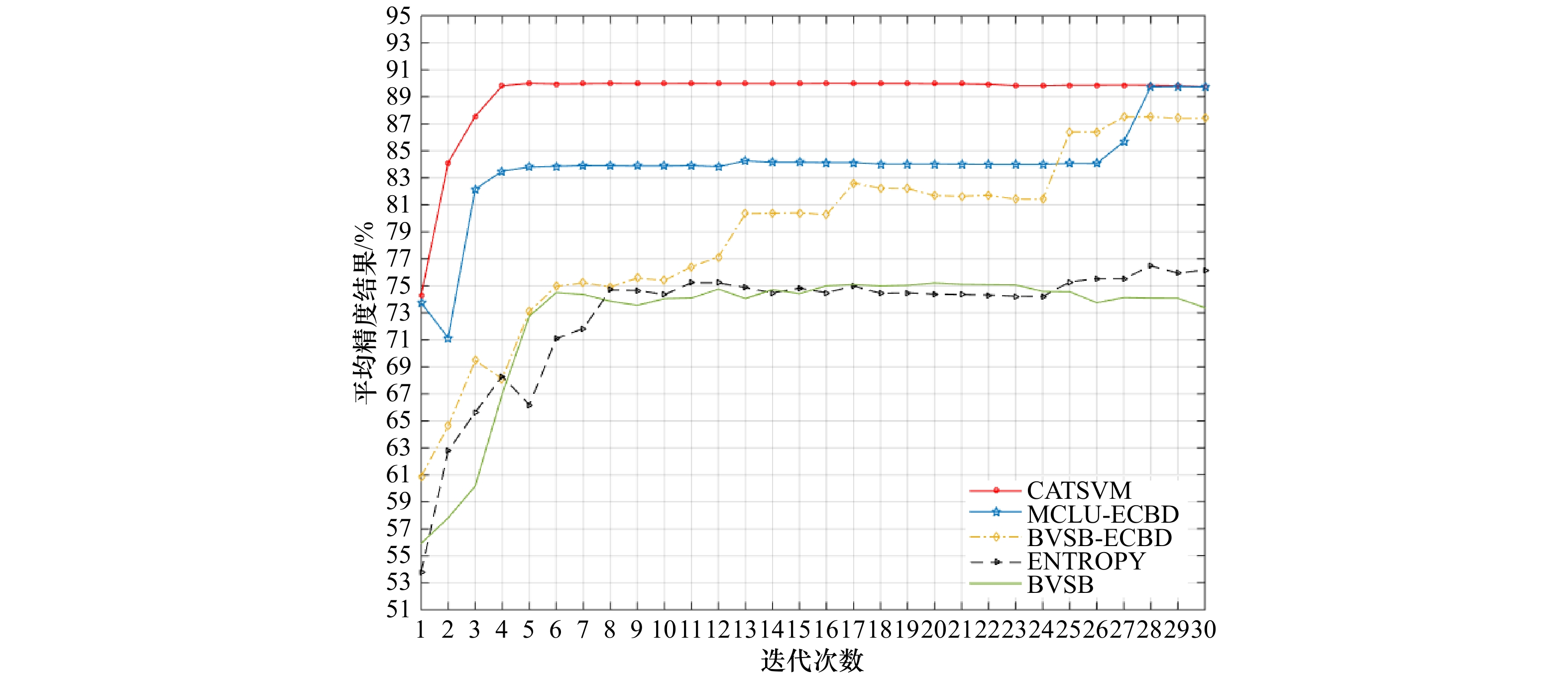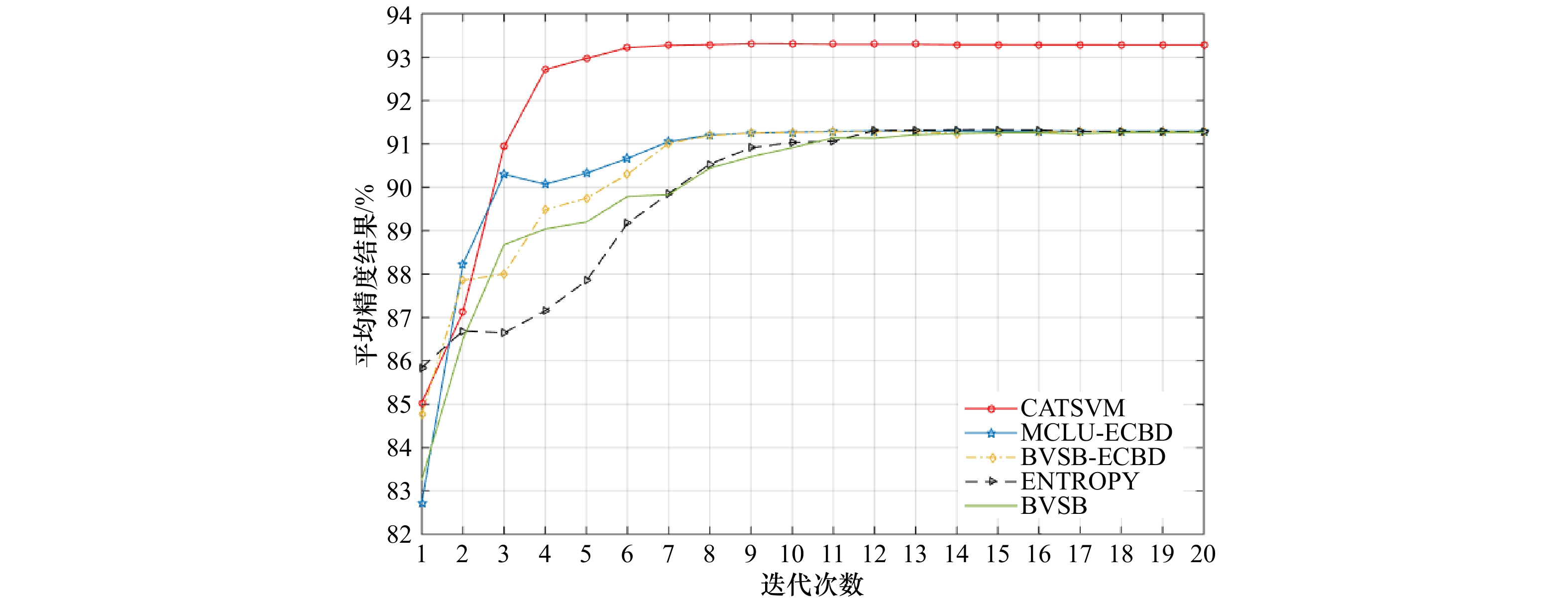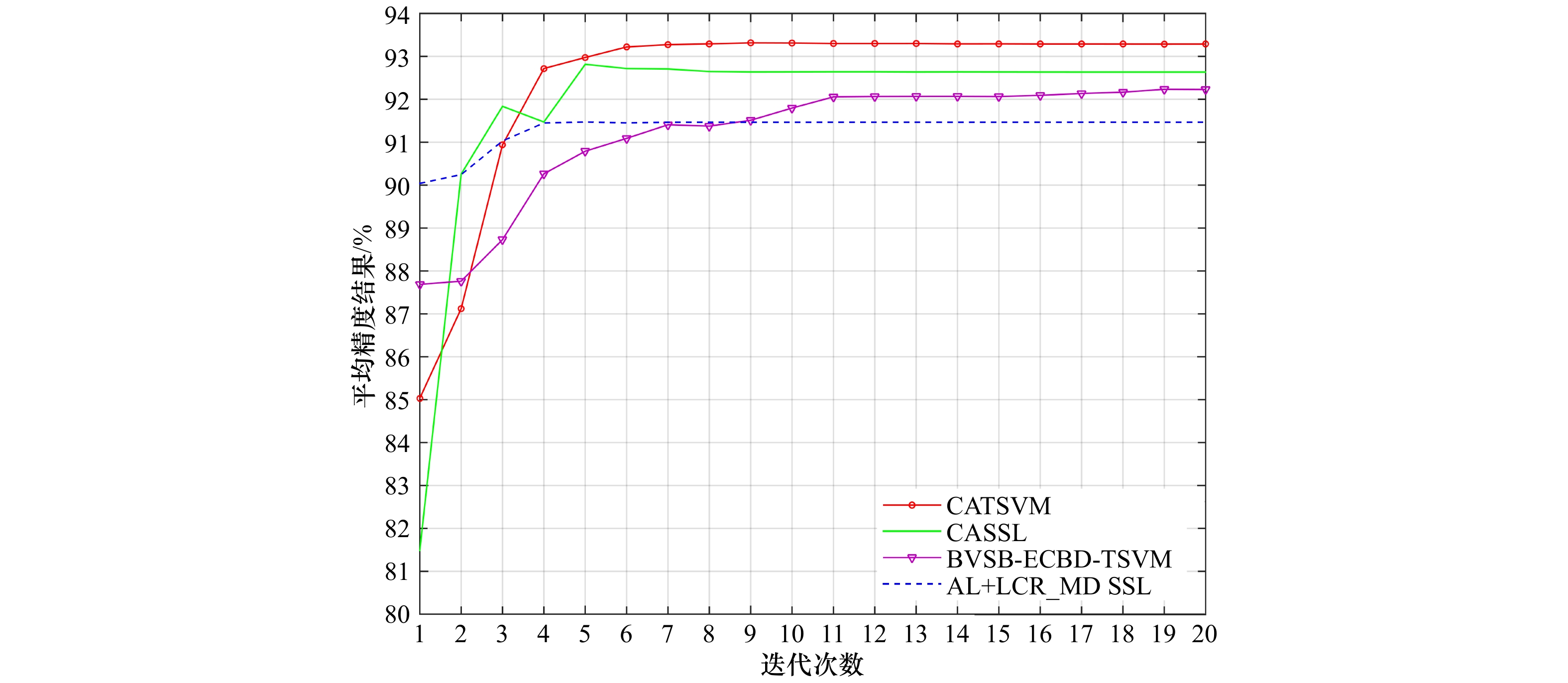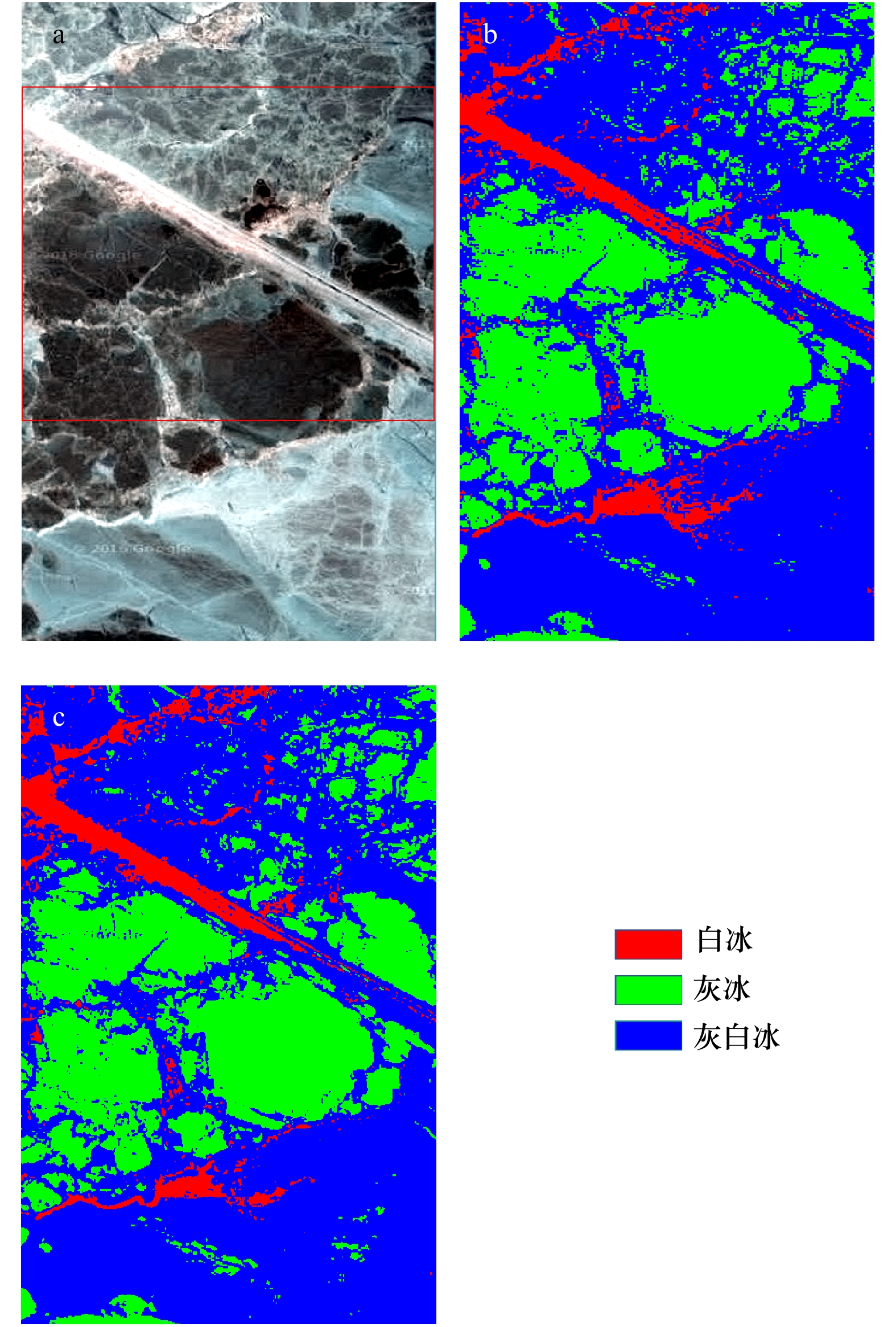Cooperative active learning and semi-supervised method for sea ice image classification
-
摘要: 海冰遥感光谱影像分类中标签样本难以获取,导致海冰分类精度难以提高,但是大量包含丰富信息的未标签样本却没有得到充分利用,针对这种情况,提出一种协同主动学习和半监督学习方法用于海冰遥感图像分类。在主动学习部分,结合最优标号和次优标号、自组织映射神经网络以及增强的聚类多样性算法来选择兼具不确定性和差异性的样本参与训练;在半监督学习部分,利用直推式支持向量机,并且融合主动学习思想从大量未标签样本中选取相对可靠且包含一定信息量的样本进行迭代训练;然后协同主动学习分类结果和半监督分类结果,通过一致性验证保证所加入伪标签样本的正确性。为了验证方法的有效性,分别采用巴芬湾地区30 m分辨率的Hyperion高光谱数据(验证数据为15 m分辨率的Landsat-8数据)和辽东湾地区15 m分辨率的Landsat-8数据(验证数据为4.77 m分辨率的Google Earth数据)进行海冰分类实验。实验结果表明,相对其他传统方法,该协同分类方法可以在只有少量标签样本的情况下,充分利用大量未标签样本中包含的信息,实现快速收敛,并获得较高的分类精度(两个实验的总体精度分别为90.003%和93.288%),适用于海冰遥感图像分类。Abstract: In the classification of sea ice remote sensing spectral images, labeled samples are obtained difficultly, which leads to difficulty improving the accuracy of sea ice classification. But a large number of unlabeled samples containing abundant information are not fully utilized. In view of this situation, a method combining active learning and semi-supervised learning is proposed to study the classification of sea ice remote sensing spectral images. The active learning part combines BVSB, SOM neural networks and ECBD algorithm to select representative samples containing uncertainty and diversity for training. The semi-supervised learning part integrates the idea of active learning use TSVM to select relatively reliable samples containing information from a large number of unlabeled samples for iterative training. Then, the results of classification and semi supervised classification are used cooperatively to guarantee the correctness of the pseudo-labeled samples through consistency verification. To verify the effectiveness of the method, Hyperion hyperspectral data with a resolution of 30 m in Baffin Bay area (the verification data is Landsat-8 data with a resolution of 15 m) and Landsat-8 data with a resolution of 15 m in Liaodong Bay (the verification data is Google Earth data with a resolution of 4.77 m) area are used for experiments of sea ice classification. The experimental results show that the cooperative classification method can make full use of the information contained in a large number of unlabeled samples in the case of a small number of label samples, and achieve rapid convergence higher classification accuracy (the overall accuracy is 90.003% and 93.288%, respectively), which verifies that the method is suitable for classification of sea ice remote sensing.
-
表 1 去除的Hyperion波段
Tab. 1 The Hyperion bands that been removed
去除波段 波长范围/nm 1~7 356~416 58~78 936~923 121~127 1 356~1 426 167~178 1 820~1 931 224~242 2 395~2 578 表 2 巴芬湾数据中每个类别的初始训练样本集L和未标签样本集U中的样本数量
Tab. 2 Number of samples for each class in the initial training set (L), and in the unlabeled pool (U) for the Baffin Bay data set
类别 L U 总计 厚冰 3 540 543 薄冰 3 536 539 海水 3 593 596 总计 9 1 669 1 678 表 3 辽东湾数据中每个类别的初始训练样本集L和未标签样本集U中的样本数量
Tab. 3 Number of samples for each class in the initial training set (L), and in the unlabeled pool (U) for the Liaodong Bay data set
类别 L U 总计 白冰 3 427 430 灰冰 3 420 423 灰白冰 3 447 450 总计 9 1 296 1 303 表 4 不同主动学习方法采样数量
Tab. 4 Number of samples chosen by the different active learning methods
方法 m h MCLU-ECBD 12 3 BVSB-ECBD 12 3 BVSB 3 − ENTROPY 3 − 表 5 CATSVM方法和其他方法的最终Kappa系数结果
Tab. 5 The final Kappa coefficient result of the CATSVM method and other methods
分类方法 Kappa系数 本文所提方法 CATSVM 0.697 主动学习方法 MCLU-ECBD 0.676 BVSB-ECBD 0.658 ENTROPY 0.497 BVSB 0.445 其他AL+SSL方法 CASSL 0.687 BVSB-ECBD-TSVM 0.673 AL+LCR_MD SSL 0.660 表 6 CATSVM方法和其他方法的最终Kappa系数结果
Tab. 6 The final Kappa coefficient result of the CATSVM method and other methods
分类方法 Kappa 本文所提方法 CATSVM 0.907 主动学习方法 MCLU-ECBD 0.826 BVSB-ECBD 0.826 ENTROPY 0.826 BVSB 0.826 其他AL+SSL方法 CASSL 0.881 BVSB-ECBD-TSVM 0.828 AL+LCR_MD SSL 0.827 -
[1] 张晰, 张杰, 孟俊敏, 等. 基于极化散射特征的极化合成孔径雷达海冰分类方法研究: 以渤海海冰分类为例[J]. 海洋学报, 2013, 35(5): 95−101.Zhang Xi, Zhang Jie, Meng Junmin, et al. Polarimetric scattering characteristics based sea ice types classification by polarimetric synthetic aperture radar: taking sea ice in the Bohai Sea for example[J]. Haiyang Xuebao, 2013, 35(5): 95−101. [2] Liu Rujie, Wang Yuehong, Baba T, et al. SVM-based active feedback in image retrieval using clustering and unlabeled data[J]. Pattern Recognition, 2008, 41(8): 2645−2655. doi: 10.1016/j.patcog.2008.01.023 [3] Joshi A J, Porikli F, Papanikolopoulos N. Multi-class active learning for image classification[C]//2009 IEEE Conference on Computer Vision and Pattern Recognition. Miami, FL, USA: IEEE, 2009: 2372−2379. [4] Demir B, Persello C, Bruzzone L. Batch-mode active-learning methods for the interactive classification of remote sensing images[J]. IEEE Transactions on Geoscience and Remote Sensing, 2011, 49(3): 1014−1031. doi: 10.1109/TGRS.2010.2072929 [5] 陈荣, 曹永锋, 孙洪. 基于主动学习和半监督学习的多类图像分类[J]. 自动化学报, 2011, 37(8): 954−962.Chen Rong, Cao Yongfeng, Sun Hong. Multi-class image classification with active learning and semi-supervised learning[J]. Acta Automatica Sinica, 2011, 37(8): 954−962. [6] Patra S, Bruzzone L. A fast cluster-assumption based active-learning technique for classification of remote sensing images[J]. IEEE Transactions on Geoscience and Remote Sensing, 2011, 49(5): 1617−1626. doi: 10.1109/TGRS.2010.2083673 [7] Patra S, Bruzzone L. A novel SOM-SVM-Based active learning technique for remote sensing image classification[J]. IEEE Transactions on Geoscience and Remote Sensing, 2014, 52(11): 6899−6910. doi: 10.1109/TGRS.2014.2305516 [8] Vapnik V, Sterin A. On structural risk minimization or overall risk in a problem of pattern recognition[J]. Automation and Remote Control, 1977, 10(3): 1495−1503. [9] Zhou Zhihua, Li Ming. Semi-supervised learning by disagreement[J]. Knowledge and Information Systems, 2010, 24(3): 415−439. doi: 10.1007/s10115-009-0209-z [10] Bruzzone L, Chi Mingmin, Marconcini M. A novel transductive SVM for semisupervised classification of remote-sensing images[J]. IEEE Transactions on Geoscience and Remote Sensing, 2006, 44(11): 3363−3373. doi: 10.1109/TGRS.2006.877950 [11] Leng Yan, Xu Xinyan, Qi Guanghui. Combining active learning and semi-supervised learning to construct SVM classifier[J]. Knowledge-Based Systems, 2013, 44: 121−131. doi: 10.1016/j.knosys.2013.01.032 [12] Wan Lunjun, Tang Ke, Li Mingzhi, et al. Collaborative active and semisupervised learning for hyperspectral remote sensing image classification[J]. IEEE Transactions on Geoscience and Remote Sensing, 2015, 53(5): 2384−2396. doi: 10.1109/TGRS.2014.2359933 [13] Han Yanling, Ren Jing, Hong Zhonghua, et al. Active learning algorithms for the classification of hyperspectral sea ice images[J]. Mathematical Problems in Engineering, 2015, 2015: 124601. [14] Joachims T. Transductive inference for text classification using support vector machines[C]//Proceedings of the Sixteenth International Conference on Machine Learning. San Francisco, CA, USA: Morgan Kaufmann Publishers Inc., 1999: 200−209. [15] Persello C, Bruzzone L. Active and semisupervised learning for the classification of remote sensing images[J]. IEEE Transactions on Geoscience and Remote Sensing, 2014, 52(11): 6937−6956. doi: 10.1109/TGRS.2014.2305805 [16] Barry P, Segal C, Carman S. EO-1/Hyperion science data user’s guide[R]. CAGE No. 11982, Redondo Beach: TRW, 2001. [17] 苏红军, 杜培军, 盛业华. 高光谱影像波段选择算法研究[J]. 计算机应用研究, 2008, 25(4): 1093−1096. doi: 10.3969/j.issn.1001-3695.2008.04.039Su Hongjun, Du Peijun, Sheng Yehua. Study on band selection algorithms of hyperspectral image data[J]. Application Research of Computers, 2008, 25(4): 1093−1096. doi: 10.3969/j.issn.1001-3695.2008.04.039 [18] Du Qian, Yang He. Similarity-based unsupervised band selection for hyperspectral image analysis[J]. IEEE Geoscience and Remote Sensing Letters, 2008, 5(4): 564−568. doi: 10.1109/LGRS.2008.2000619 [19] Chang C C, Lin C J. LIBSVM: a library for support vector machines[J]. ACM Transactions on Intelligent Systems and Technology, 2011, 2(3): 27. [20] Han Yanling, Li Peng, Zhang Yun, et al. Combining active learning and transductive support vector machines for sea ice detection[J]. Journal of Applied Remote Sensing, 2018, 12(2): 026016. -




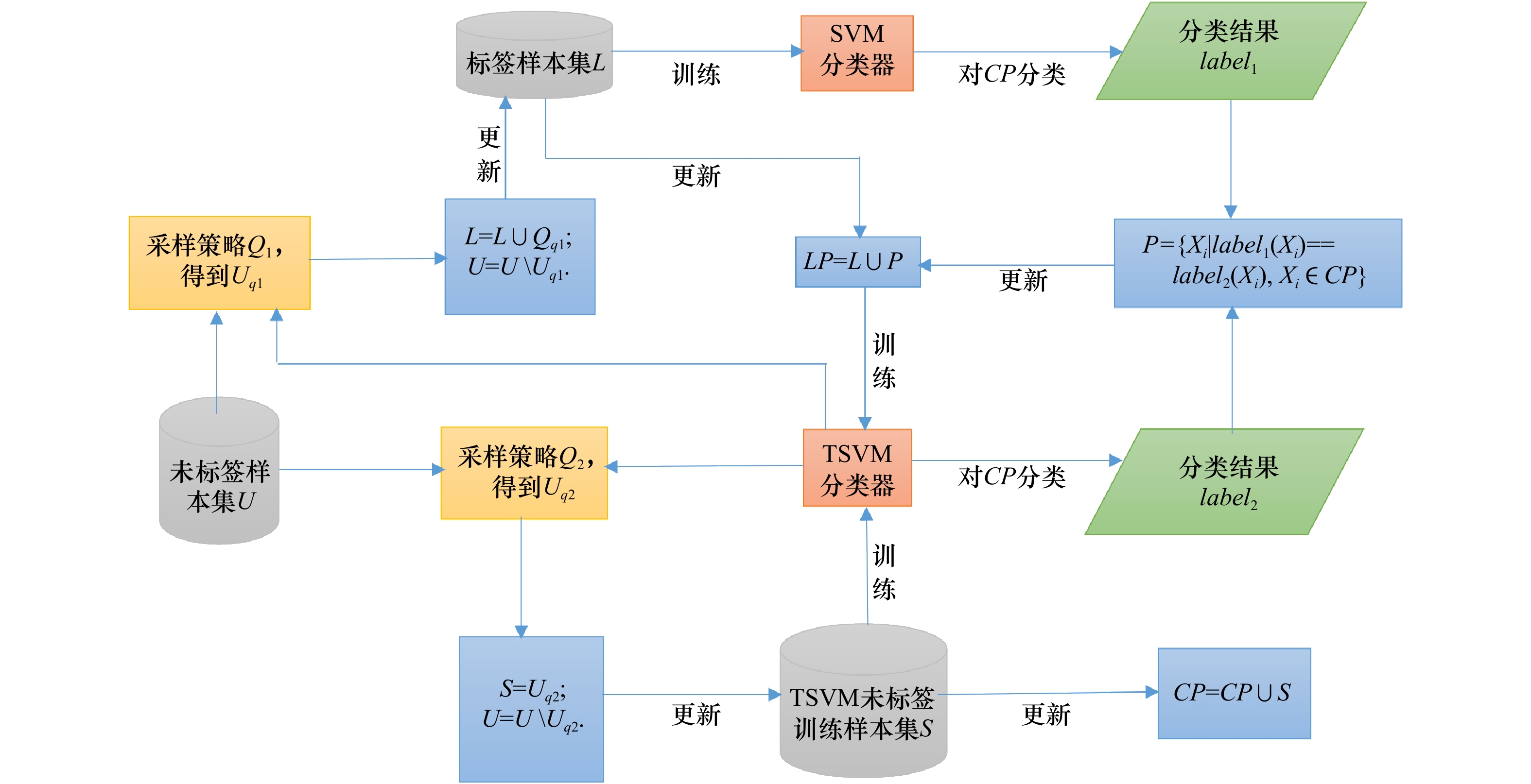
 下载:
下载:


